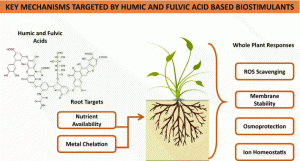Recent years have seen an explosion of products termed “biostimulants”. What is biostimulants? Are they a good alternative to traditional chemical products? Due to the recent outbreak of citrus greening in Florida, UF/IFAS has been conducting research on different types of plant biostimulants to determine if they are beneficial to the citrus trees.

What Are Biostimulants?
Although there isn’t a legal definition for biostimulants, they are usually defined as substances and/or microorganisms that when applied to plants or the rhizosphere stimulate natural processes to benefit nutrient uptake, nutrient efficiency, tolerance to abiotic stress, and/or crop quality, independent of their nutrient content.
Availability
Biostimulants are available in many formulations and with varying ingredients. Among the most popular ingredients are humic substances, seaweed extracts, and beneficial bacteria and fungi.
- Humic Substances: Collections of natural components of the soil organic matter with relatively low molecular mass that result from decomposition of plant, animal and microbial residues, and the metabolic activities of soil microbes. Most sources of humic substances used in agriculture are nonrenewable and include natural deposits of humified organic matter such as peat and mineral deposits such as leonardite and soft coal.
- Dark in color

- Higher molecular weight and carbon content
- Higher degree of polymerization.
- Positive effects on plants are improvement of root nutrition and lateral root development. Increase of the soil cation exchange capacity is one of the reasons for these effects.
- Dark in color
- Beneficial Bacteria: Promote plant growth or plant growth-promoting rhizobacteria (PGPRs).
- Free-living bacteria inhabit the zone around the root, bacteria that colonize the root surface and bacteria that live within the roots.
- Many PGPRs emit volatile organic compounds, which may improve pant growth and productivity, and induce resistance to bacterial pathogens present in the rhizosphere.
- Performance and relationship with native soil bacteria, particularly in citrus, is still largely unknown.
- Beneficial Fungi: Found in the group of symbiotic fungi, particularly arbuscular mycorrhizal fungi (AMF), which penetrate roots where they form nutrient-exchange structures called arbuscules.
- Enables the plant to extend the reach of the root system beyond the depletion zone, allowing for enhanced uptake of nutrients and water.
- Difficulties associated with reliance on AMG is their susceptibility to different crop management practices; distribution by soil tillage, lack of plant host diversity in monoculture, and suppression by high levels of fertilizers and fungicides.

- Other plant-beneficial fungi are found in the soil or on dead wood and bark. Trichoderma are known to promote root-branching and nutrient uptake. Due to their ability to parasitize other fungi, they are often used as biocontrol agents for fungal disease of plants.
- Seaweeds: Soluble powders or liquid formulations derived through different extraction procedures. The biological activity of these extracts depends on the raw material and the extraction process.
- One major component is polysaccharides, which may account for 30-40 percent of the dry weight and include alginates and laminarins.
- Known to elicit plant defense responses against fungal and bacterial pathogens.
- Rich in phenolics, compounds with antioxidant activity that play an important role in scavenging highly reactive and plant cell-damaging free radicals.
- Positive attributes are their soil-conditioning and metal chelating properties as well as their ability to positively influence the water-retention capacity of soils.
Biostimulant Research in Citrus
As root health is critical to tree performance, especially in the HLB era, UF/IFAS researchers are interested in deciphering the effects of biostimulant substances on the root/soil microbial community, and possible interactions with the rootstock genotype. Several field studies are currently in progress, including young trees as well as mature trees in commercial operations. These studies will aid in deciphering possible impacts of biostimulants on root health and the root/soil environment before effects become visible in the above-ground portion of the tree. Thus far, no above-ground differences have been observed between plants receiving biostimulant products and those that do not. This is not surprising, considering the trials were initiated only within the last year.
There are many biostimulant products of varying composition that are currently on the market. Potentially positive effects on different crops have been reported in scientific literature, however there is little knowledge regarding biostimulant effects on commercially grown citrus. Rootstock/scion combination, the source and composition of materials, the dose and manner of application, environmental conditions and management practices all affect the reaction of biostimulants. In general, biostimulants are more effective under stress conditions.
If you would like to know more about biostimulants, please contact your local UF/IFAS Extension office.
 0
0


